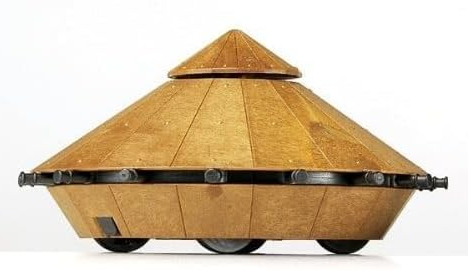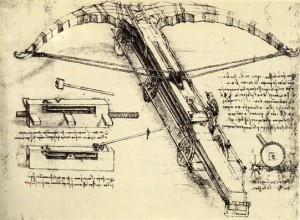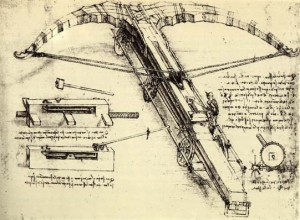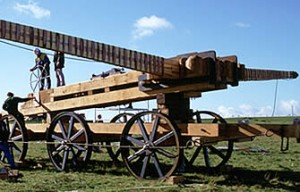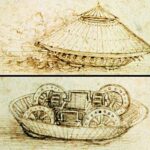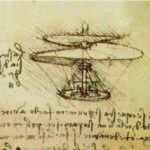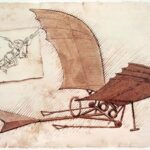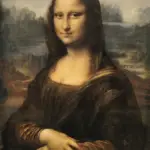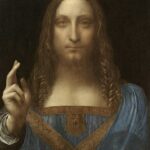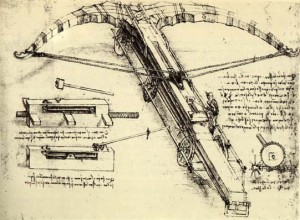
by Dukgyu | Apr 12, 2022 | war machines
Leonardo da Vinci War Machines
Leonardo da Vinci, commonly known as Leonardo, was an Italian polymath of the High Renaissance. His interests and talents spanned a multitude of disciplines, making him an epitome of a “Renaissance Man“. Leonardo’s name has become synonymous with unending curiosity and creative ingenuity.
Often revered for his artistic masterpieces like the Mona Lisa and The Last Supper, da Vinci was not just a painter but a person of numerous other talents. A closer look at his life reveals a deeply complex individual who possessed an insatiable thirst for knowledge. He was an artist, a scientist, a musician, an engineer, and an inventor, among many other things. His sketches and notebooks that have survived till date, illuminate his genius in a variety of fields.
I) The Dichotomy Between da Vinci as an Artist and Engineer
Leonardo da Vinci’s biography presents an interesting dichotomy. While most people recognize him as a masterful artist, he was also a groundbreaking engineer. In fact, he often blurred the lines between these two roles, using his artistic skills to illustrate his engineering designs and employing his knowledge of physical properties to inform his art.
A careful perusal of Leonardo’s drawings and sketches like the iconic Vitruvian Man show the perfect amalgamation of his two passions: art and science. This interplay between disciplines is what truly set Leonardo apart. He utilized his artistic skills to illustrate complex engineering and mechanical designs, allowing future generations to understand and appreciate his genius.
II) Da Vinci’s Interest in War Machines
Leonardo’s fascination with war machines is evident from his time spent in the service of Cesare Borgia, a notorious military leader during the Renaissance. His role as a military engineer led him to design an array of innovative war machines. These were not just limited to improvements on existing technology but were revolutionary ideas, far ahead of their time.
From his sketches of giant crossbows to plans for armored vehicles (a rudimentary form of a modern tank), Leonardo’s war machines were designed with a deep understanding of physics and mechanical engineering. Some of his most ingenious designs include the Leonardo Machine Gun, an armored car that’s considered the precursor to the modern tank, and a helicopter model that resembled an aerial screw.
I. The Military Engineer
I) Da Vinci’s Role as a Military Engineer
Beyond the artistic realm, Leonardo da Vinci held an equally fascinating role as a military engineer. His knack for creative innovation translated well into this field, allowing him to conceptualize devices and mechanisms that were far ahead of his time. During his time serving various patrons, including Ludovico Sforza, the Duke of Milan, and later, Cesare Borgia, he developed a series of designs for military machinery and fortifications.
One might imagine that a creative mind like Leonardo’s would be at odds with the grim realities of war. However, he ingeniously combined his artistic abilities with his knowledge of science to conceive mechanisms of defense and assault. He worked on enhancing fortifications, improving weaponry, and even devised plans for diverting rivers to impede enemy advances.
II) The Context of War During Da Vinci’s Lifetime
The context of war during Leonardo’s lifetime played a significant role in shaping his inventions. The Italian Wars, a series of violent conflicts involving the major powers of Western Europe, were underway. This meant that there was a constant demand for new, efficient ways of dealing with threats and attackers.
These were times of turmoil and strife, and leaders sought to gain the upper hand by investing in advanced warfare technology. Leonardo, with his forward-thinking ideas and inventions, was a valuable asset in these endeavors. His designs were not just solutions to problems of his time; they were visionary ideas that far surpassed the capabilities of the era he lived in.
III) Why Did Leonardo Da Vinci Make Weapons?
Leonardo da Vinci was, at heart, a man of peace who once wrote that he was ‘sorry to be the cause of death.’ So why did he design weapons? A significant reason was practicality. During his lifetime, designing military machinery was a financially lucrative endeavor. Patrons sought out Leonardo for his innovative mind, and he needed their patronage to fund his research and other works.
Furthermore, despite his personal misgivings about warfare, Leonardo understood that war was a reality of his time. By designing weapons, he could contribute in a way that might help end conflicts faster and potentially save lives. Ultimately, his role as a military engineer showcases the dichotomy of a man who, in one hand, created some of the world’s most beautiful art, and in the other, designed instruments of war. This contrast contributes to the enduring fascination with Leonardo da Vinci, the true Renaissance Man.
II. Da Vinci’s Military Inventions
I) Da Vinci Machine Gun
Leonardo da Vinci’s Machine Gun, also known as the 33-barrelled organ, is one of his most inventive military designs. This early concept of rapid-fire artillery featured 33 small-caliber guns, arranged in three rows of 11. The idea was that one row could be fired while the other two were cooling and being reloaded, providing a consistent barrage of firepower against enemy lines.
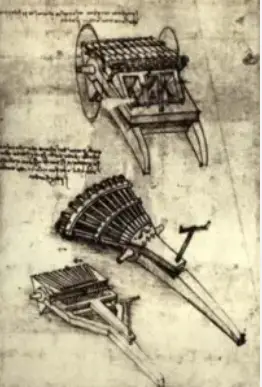
Da Vinci Machine Gun Design
However, did da Vinci create a machine gun? The answer requires a nuanced understanding of da Vinci’s design. While his 33-barrelled organ does resemble a machine gun in concept, it does not function with the automatic reloading mechanism characteristic of modern machine guns. Therefore, while da Vinci can be credited with conceptualizing the precursor to the machine gun, the technology of his time did not permit the full realization of the concept.
II) Da Vinci Armored Car
Leonardo also envisioned what can be seen as a precursor to the modern tank – da Vinci’s Armored Car. This design featured a circular platform on wheels, encased in a protective shell, and equipped with an array of light cannons. The armored car was intended to intimidate and scatter enemy forces while keeping its occupants safe.
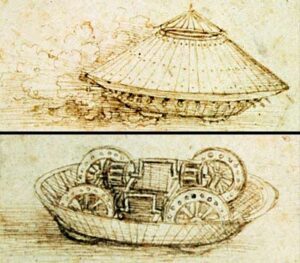
Leonardo da Vinci Tank Design
Its resemblance to modern tanks lies in its core principles: mobility, protection, and firepower. Like the modern tank, da Vinci’s armored car was a mobile artillery platform, providing a means of delivering firepower while offering protection to its occupants.
III) Da Vinci Giant Crossbow
One of Leonardo’s most visually stunning war machine designs was the Giant Crossbow. This massive siege engine, spanning 27 yards, was intended to hurl large stones or flaming bombs at enemy fortifications. Although it’s unclear if the giant crossbow was ever built, its design stands as a testament to da Vinci’s creativity and his understanding of mechanics and leverage.

Leonardo da Vinci’s Giant Crossbow Design
IV) Da Vinci Catapult
The da Vinci Catapult, a design attributed to the renowned Renaissance polymath Leonardo da Vinci, is a compelling example of his innovative approach to warfare machinery. A model of ingenuity and practical design, this machine was created to catapult or hurl projectiles at enemy fortifications.
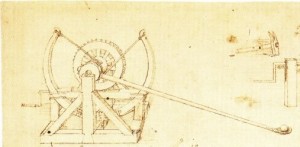
Leonardo da Vici’s Catapult Design
III. Da Vinci’s Other War Machines
Leonardo’s military innovations didn’t stop there. He also designed various other less-known war machines, such as:
- Scythed Chariot: A vehicle designed to slice through enemy lines with large, rotating blades attached to its wheels.
- Multi-barreled Cannon: An artillery piece with several barrels for simultaneous firing, intending to cause extensive damage to enemy ranks.
- Revolving Bridge: A portable, fast-deployable bridge that could be spun around to allow allied troops to cross water bodies swiftly, or to act as a barricade.
IV. Da Vinci’s Influence
One cannot speak of military innovations without acknowledging the indelible mark left by Leonardo da Vinci. His remarkable designs not only bear the hallmark of his genius but also laid the foundation for modern warfare.
I) How Have Da Vinci’s Designs Influenced Modern Military Equipment?
From his concept of a machine gun to the design of an armored vehicle, Leonardo’s innovative ideas resonate in the heart of today’s military hardware.
- Machine Gun: Da Vinci’s 33-barrelled organ was an early glimpse into rapid-fire artillery. Modern machine guns, while vastly more advanced, incorporate the same basic idea of providing a continuous stream of fire.
- Armored Vehicles: Leonardo’s armored car was a precursor to modern tanks. The design, which integrated mobility, protection, and firepower, has been realized in today’s battlefields with tanks and armored vehicles.
- Siege Engines: Da Vinci’s giant crossbow is an example of his understanding of mechanical principles used in artillery and siege warfare. Modern artillery still uses the fundamental principle of leveraging mechanical force to launch projectiles.
- Multifunctional Design: His concept of a revolving bridge, which could be used both for crossing bodies of water and as a barricade, is echoed in the multifunctional equipment and flexible strategies in use by modern armies.
V. Da Vinci’s Attempts to Conquer the Sky
Da Vinci’s visionary genius didn’t stop on the ground. His fascination with flight led him to design various flying machines, a testament to his undying quest for innovation and his relentless pursuit to conquer the skies.
I) Did Any of Da Vinci’s Flying Machines Work?
While none of da Vinci’s aerial inventions were built or tested during his lifetime, his theoretical designs demonstrated a deep understanding of the principles of flight.
- Aerial Screw: This was da Vinci’s interpretation of a helicopter, intended to rise by cutting through the air with its spiral rotor. While the technology of the time couldn’t produce a functional version, the concept foreshadowed modern helicopters.
- Glider: The glider design showcased da Vinci’s study of birds’ flight. The design harnessed the principles of lift and drag, which are fundamental to modern aviation.
- Parachute: Da Vinci’s parachute was a pyramid-shaped canvas canopy that would allow a person to descend slowly from a height. Modern parachutes adopted this principle, though they favor a more practical dome shape.
II) Da Vinci’s Vision
Why did da Vinci pursue flight, beyond its military applications? Da Vinci saw flight as the ultimate expression of human freedom and potential. His detailed studies of bird flight in his sketchbooks hint at his fascination with flight as a natural phenomenon, and a challenge for humanity to overcome. Da Vinci saw flight not just as a military advantage, but as a paradigm-shifting advance for all of humanity, reflecting his boundless vision and unwavering commitment to progress.
VI. Other Inventions by Leonardo da Vinci
While Leonardo da Vinci is well known for his military inventions, his genius extended far beyond the battlefield. His limitless curiosity and innovative spirit led him to explore and contribute to a variety of other fields, leaving a rich legacy of non-military inventions.
I) Leonardo’s Inventions Outside of Military Applications
Apart from his military inventions, da Vinci made significant contributions to the fields of civil engineering, hydraulics, anatomy, and more. His inventiveness was fueled by a desire to understand and improve the world around him. From studying the human body to devising plans for city improvements, da Vinci’s ideas transcended the knowledge of his time.
II) Three Key Non-Military Inventions by da Vinci
Here are three key inventions by Leonardo da Vinci that were not related to warfare:
- Self-Propelled Cart: Often considered the precursor to the modern car, da Vinci’s self-propelled cart was designed to move without being pushed. This machine, though never built during his lifetime, demonstrates Leonardo’s forward-thinking vision.
- Anatomical Studies: While not an ‘invention’ in the typical sense, da Vinci’s detailed drawings of the human body, based on careful dissections, were far ahead of his time. His anatomical studies have greatly contributed to medical science.
- Viola Organista: Da Vinci was also a musical visionary. He designed a musical instrument called the viola organista, which combined elements of a harpsichord and a violin. While it was never built during his lifetime, modern versions showcase its unique, ethereal sound.
Da Vinci’s genius was not limited to art or war machines but permeated into every field he touched. His diverse range of inventions bear witness to his insatiable curiosity and unparalleled ability to innovate.
Conclusion
In retrospect, the genius of Leonardo da Vinci holds a profound influence on our modern world, especially in military technology. His forward-thinking designs, conceived over 500 years ago, continue to inspire and inform contemporary engineering practices.
Leonardo da Vinci’s military machines, from the multi-barreled cannon to the armored car and giant crossbow, have laid the conceptual groundwork for many technologies we see today. His designs mirror the principles found in contemporary military equipment, proving the timelessness of his ideas. Even in areas where his inventions did not directly translate to practical machines, they sparked a progressive line of thought that permeates today’s engineering marvels.
Home
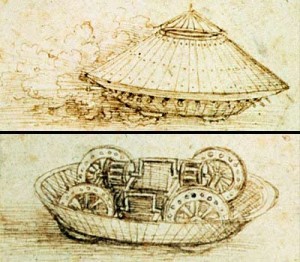
by Dukgyu | Mar 24, 2022 | war machines
Leonardo da Vinci Tank
Leonardo da Vinci is renowned as one of the most gifted polymaths in history. Known for his unsurpassed intellect and tireless curiosity, he made innumerable contributions across various fields, including art, science, music, invention, and more. But perhaps one of his most intriguing roles was that of a military engineer.
This facet of Leonardo’s genius gave us one of the most groundbreaking inventions in the history of warfare technology – the Leonardo da Vinci tank, also often referred to as da Vinci tank.
The innovative concepts embodied in Leonardo da Vinci’s designs, such as the da Vinci tank and the giant crossbow, set the stage for the future of warfare technology.
Although the technology of his time couldn’t bring these ideas to life, these innovative concepts remain a testament to da Vinci’s extraordinary imagination.
This armored tank, an invention centuries ahead of its time, reflected Leonardo’s genius and his unique ability to observe, understand and manipulate the principles of nature and mechanical forces.
So, let’s dive into the world of Leonardo da Vinci’s warfare technology, focusing on his extraordinary design for the tank.

Leonardo da Vinci Tank Design
Leonardo’s fighting vehicle was designed to be driven straight onto a battlefield and to decimate the enemy with its 360-degree cannons.
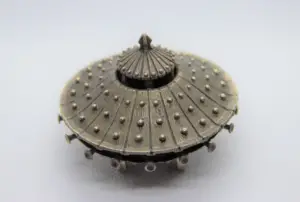
Leonardo da Vinci Tank – Real model
The Conception of da Vinci’s Armored Car
The da Vinci Tank, also known as the da Vinci Armored Tank or Davinci Tank, was one of Leonardo’s most revolutionary concepts.
This early iteration of a mobile fortress represents one of the earliest conceptions of what we today understand as a tank.
What was the da Vinci Tank called?
Leonardo’s innovative war machine was typically referred to as the Leonardo da Vinci Tank or the Leonardo da Vinci Armored Car.
Though we now recognize it as a precursor to the modern tank, it’s worth noting that Leonardo himself wouldn’t have used the term “tank” as it was not coined until World War I.
Origins and Initial Design Concepts
Leonardo’s notebook, the Codex Atlanticus, houses the design of the Leonardo da Vinci armored tank among many other drawings and ideas. It’s a window into his vast intellect and unwavering curiosity.
The Leonardo da Vinci tank design was groundbreaking for its time. Conceived as a mobile fortress, it was intended to intimidate and scatter an opposing army.
The design proposed a circular platform mounted on four wheels and powered by manpower from within. The platform was to be covered by a large protective shell, designed with a sloping surface to better deflect enemy fire.
The Leonardo tank was designed to carry a crew of eight, with an array of light cannons protruding from the sides of the tank. The intention was to create a vehicle that could move in any direction and cause widespread damage without exposing the crew to direct harm.
Why did Leonardo da Vinci invent the tank?
Leonardo was a pacifist at heart, but he was also a practical man living in turbulent times. He offered his skills as a military engineer to the Duke of Milan, Ludovico Sforza, and later Cesare Borgia, in a bid to secure patronage.
The creation of the Leonardo da Vinci tank invention was part of his efforts to impress his patrons with innovative war machines that could give them the edge in battle.
By inventing the Leonardo davinci tank, he hoped to revolutionize warfare by offering a means of protection to soldiers while giving them the capability to counter-attack from within a mobile fortress.
He aimed to leverage the principles of mechanics to deliver a war machine that was both offensive and defensive – the very concept that underpins the design of modern tanks.
The Design of Leonardo’s Fighting Vehicle
The da Vinci tank design was a remarkable blend of innovation, creativity, and practical understanding of mechanics.
Let’s delve deeper into the intricacies of this design by examining the Leonardo da Vinci tank blueprints, sketches, and model.
Leonardo da Vinci Tank Blueprints and Sketches
The blueprints and sketches of the Leonardo da Vinci tank, found in the Codex Atlanticus, show a circular platform, powered by two large inside cranks operated by the crew.
The cranks were attached to a system of gears, connected to the wheels, allowing the tank to move in any direction.
The exterior of the tank was to be covered in a protective shell, like the shell of a tortoise, with light cannons protruding through the many holes on the sides of the tank.
This armored shell was designed to protect the crew while providing an all-round field of fire.
Leonardo da Vinci Tank Model
Models of the Leonardo da Vinci tank based on his sketches show a bulky, circular fortress-like structure. The cranks and gears necessary for motion are housed inside, along with provisions for the crew to operate the cannons.
One interesting point about the design of the tank is that the gearing system, as drawn by Leonardo, wouldn’t actually work. The gears were set up in such a way that the wheels would cancel each other out, leaving the tank stationary.
Some historians believe this may have been an intentional flaw, inserted by Leonardo due to his discomfort with the idea of his inventions being used for war. Others argue it was simply an oversight.

Did Leonardo da Vinci design the first tank?
While the term ‘tank’ wasn’t coined until centuries later during World War I, the basic concept of a covered, mobile, and armed fortress that Leonardo proposed does qualify as a primitive tank design. Therefore, it’s accurate to say that Leonardo da Vinci designed what could be considered the very first concept of a tank.
It’s important to note, however, that Leonardo’s tank was never built during his lifetime and remained on paper as part of his vast collection of designs and ideas. It wasn’t until the 20th century that technology advanced enough to build functional tanks, but Leonardo’s concept was a significant precursor to these modern machines.
The Functionality and Limitations of the da Vinci Armored Tank
The Leonardo Tank is a fascinating historical concept that continues to intrigue scholars and enthusiasts today.
But how would it have fared in practice? Would it have truly revolutionized warfare, or were there inherent flaws in its design that would have rendered it ineffective?
Was the da Vinci Tank Ever Used in Battle?
No historical record suggests that the da Vinci Armored Tank was ever built or used in battle during Leonardo’s lifetime.
In fact, the technical capabilities of the 15th century were insufficient to create a working model of the tank.
The lack of powerful engines meant that the tank would have to be powered by the manpower of its crew, which would likely have rendered it slow and difficult to maneuver.
The Major Flaw in da Vinci’s Tank Design
- The most significant issue with the da Vinci Tank design is the gear mechanism. As Leonardo sketched it in the Codex Atlanticus, the gears would cancel each other out, leaving the tank immobile.
- This apparent flaw has led to a great deal of speculation. Some scholars argue that Leonardo, a known pacifist, may have deliberately included this flaw to prevent his design from being used for warfare. Others, however, believe it could have been an oversight. Despite his genius, Leonardo was human and thus prone to occasional errors.
- Another potential issue is the tank’s weight. The armored shell, cannons, and the crew, all mounted on a moving platform, would have made it extremely heavy. With only human power for propulsion, it would have been challenging to move, particularly on rough terrains common in battlefields.
Regardless of these flaws, the concept of the Leonard tank demonstrates an astonishing level of innovative thinking. The idea of a mobile, armored vehicle that could protect its occupants and carry firepower was centuries ahead of its time, and it paved the way for the development of modern tanks.
The Significance of the Leonardo da Vinci Tank Invention
Despite never having been built, the Leonardo da Vinci tank stands as a testament to the genius and forward-thinking of its creator. It has particular significance in Leonardo’s body of work and the broader field of warfare technology.
Da Vinci’s Innovations and Inventions
Leonardo da Vinci was not merely an artist, but a scientist, engineer, and inventor. His body of work stretches across numerous disciplines, each teeming with innovative ideas and insights.
His designs ranged from a printing press and parachute to a self-supporting bridge.
The tank, or the armored car, adds to the diversity and depth of da Vinci’s work, proving yet again his ability to think beyond the boundaries of the possible and conceive ideas far ahead of his time.
Leonardo da Vinci’s Contributions to Warfare Technology
Leonardo’s designs played a significant role in redefining warfare technology. From the giant crossbow to the tank, his inventions showed a deep understanding of both the mechanics and the tactics of warfare.
While the tank never saw a battlefield during Leonardo’s time, it was a forerunner to modern tanks, introducing the idea of a protected, mobile fortress armed with firepower.
This concept reshaped warfare tactics and strategies, leading to a new era of armored warfare.
The da Vinci tank is more than just an invention. It is a testament to the timeless genius of its creator, a landmark in the evolution of warfare technology, and a symbolic representation of the boundless capacity of human ingenuity.
In action
The Evolution of the Armored Tank
The Leonardo da Vinci tank, though never built in its original form, set the stage for the advent of the armored tank as we know it today.
Let’s take a brief tour through the history of the tank, from its conceptual origins with Leonardo to the muddy battlefields of World War I.
The Invention of the Tank and Its Inventor
While da Vinci was the first to conceive of a mobile, armored vehicle, it was not until the 20th century that the tank, as we recognize it today, was developed.
The invention of the tank is typically credited to the British during World War I. The British “Mark I” tank was the first tank to enter combat, deployed at the Battle of Flers-Courcelette on September 15, 1916.
But, a very important precursor to this modern tank was developed by the French mechanical engineer Léon Levavasseur, who patented a design for a vehicle with a “self-contained fuel source” in 1903.
The First Modern Tank
The Mark I tank was designed to overcome the problems of trench warfare, which had resulted in a deadly stalemate along the Western Front.
It was a far cry from the circular da Vinci tank, with a long, rhomboidal shape designed to cross trenches, and a fully enclosed armored hull to protect its crew.
Equipped with powerful petrol engines, these tanks didn’t need the crew to manually move it like Leonardo’s tank would have.
Da Vinci Tank vs. World War I Tank Design
|
Da Vinci’s Tank Design |
World War I Tanks |
| Size and Complexity |
Smaller and simpler |
Larger and more complex |
| Power Source |
Not specified (likely human or animal powered) |
Combustion engines |
| Weaponry |
Not specified |
Large-caliber guns and machine guns |
| Terrain Navigation |
Likely struggled with difficult terrain |
Tracks designed to navigate difficult, muddy terrains |
| Practicality on Battlefield |
Visually striking but likely had practical challenges |
Long, tracked design was more practical |
| Overall Impact |
Conceptual stage, never built in his lifetime but showed innovative thinking |
Used in battle, showed the effect of technological advancements |
While da Vinci’s concepts never saw fruition in his lifetime, his innovative thinking paved the way for later inventors to conceive and develop the armored vehicles that revolutionized warfare in the 20th century.
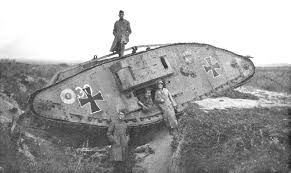
A tank of World War I
2005 Model of the tank, one of the inventions of Leonardo in the Clos Luce mansion. Leonardo da Vinci lived there for the last three years of his life, and died.

2005 Model of da Vinci Tank – Amboise, France
Conclusion
In this exploration of the Leonardo da Vinci tank, we’ve traversed the intricate corridors of history, innovation, and imagination. From the bustling workshops of Renaissance Italy to the grim battlefields of World War I, the story of the tank is as much a journey through human creativity as it is a testament to technological progress.
We delved into the origins of the tank, initially conceptualized by Leonardo da Vinci as an armored car. We examined the intricate details of da Vinci’s tank design, discovering how it was far ahead of its time. We found out that the tank was not utilized during da Vinci’s lifetime and identified a key flaw in its design.
Despite these limitations, we understood the immense significance of the da Vinci tank invention in the grand scheme of warfare technology. The final part of our exploration led us through the evolution of the armored tank, beginning from Leonardo’s drawings to the behemoths of World War I.


Home






